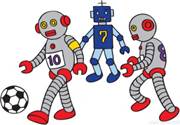题目内容
They ______ a slide show about typhoons now.
- A.watched
- B.saw
- C.are seeing
- D.are watching

 阅读快车系列答案
阅读快车系列答案
| |||||||||||||||||||||||||||||||||||||||||||||||||||||||||||
Last weekend, twenty thousand people gathered in the state of Georgia to watch students from twenty-eight countries compete with robots they built. More than ten thousand students and more than five hundred robots took part in the competition.
Almost one thousand and seven hundred high school teams entered a level of competition called LUNACY. The competitors came from eleven countries, including the United States. In January, the organization sent the same supplies for robots to each team. The teams had six weeks to build robots that could compete in the LUNACY game. The playing area had six robots, three on each team. Each robot had a trailer(拖车) connected to it. The robots had to pick up large balls and throw them into the trailers of opposing robots. The robots were moving on a surface where they could slide(滑行). A team from California won the competition.
A second competition involved building a robot that could travel on uneven(不平坦的) surfaces, move objects with unusual shapes and withstand(承受) physical stress.
Another competition was for younger students, aged nine to fourteen years old. Eighty-four teams from twenty-seven countries competed with robots made with LEGO products. They had to design, build and program robots to explore the Earth’s climates.
【小题1】The competitors coming from _______countries entered a level of competition called LUNACY.
| A.twenty-eight | B.twenty-seven |
| C.eighty-four | D.eleven |
| A.Schools | B.Volunteers |
| C.The government | D.The organization |
| A.two | B.three | C.six | D.eight |
| A.included | B.removed | C.corrected | D.invented |
| A.In January, each team got the same supplies for robots. |
| B.A team from California won the LUNACY competition. |
| C.The writer introduces three kinds of competitions in this passage. |
| D.The students had to design or buy robots for the competition. |



 Almost one thousand and seven hundred high school teams entered a level of competition called LUNACY. The competitors came from eleven countries, including the United States. In January, the organization sent the same supplies for robots to each team. The teams had six weeks to build robots that could compete in the LUNACY game. The playing area had six robots, three on each team. Each robot had a trailer(拖车) connected to it. The robots had to pick up large balls and throw them into the trailers of opposing robots. The robots were moving on a surface where they could slide(滑行). A team from California won the competition.
Almost one thousand and seven hundred high school teams entered a level of competition called LUNACY. The competitors came from eleven countries, including the United States. In January, the organization sent the same supplies for robots to each team. The teams had six weeks to build robots that could compete in the LUNACY game. The playing area had six robots, three on each team. Each robot had a trailer(拖车) connected to it. The robots had to pick up large balls and throw them into the trailers of opposing robots. The robots were moving on a surface where they could slide(滑行). A team from California won the competition.